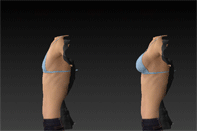How well you take care of yourself after your breast augmentation surgery can significantly influence how quickly you heal—and whether or not you might experience post-surgery complications.
The surgeon’s expert hands have done his part of the job. After you’ve been cleared to leave the plastic surgery office, the rest is now up to you. There are a few things that you should refrain from doing in the first few days to weeks after your breast augmentation surgery.
Following the below advice will help ensure that you will heal quickly, don’t injure yourself, or inadvertently cause any complications to arise. Here are our top five tips on what NOT to do after your breast implant surgery:
1. Don’t Take Advice from Dr. Google
A quick Google search will provide a ton of information on how to start the healing process from your breast surgery. The problem with taking advice from Google is that most of it is coming from people who haven’t gone through the same extensive medical training that your plastic surgeon did.
This is why you should listen to the advice of your surgeon. If you have a question that he didn’t answer, don’t hop onto the internet to find medical advice from people who don’t have a medical degree. You could potentially wind up doing more harm than good.
Instead, call the plastic surgeon’s office, and the receptionist will be more than glad to put you in touch with the surgeon—who answer any questions you might have.
2. Don’t Exercise Right Away
Do not start exercising until your surgeon gives you the clearance to do so. In the immediate days and weeks following your surgery, your body is in full repair mode. It’s trying to heal up from the surgery and needs every bit of energy it can get.
Even if you start to feel better and are itching to hit the gym again, don’t exercise unless your surgeon gives you the O.K. Your new breasts might not be physically ready for the impact of exercising and you could inadvertently cause complications to arise.
3. Don’t Smoke or Drink
Booze is a big no-no in the weeks leading up to and following your surgery. Alcohol of any strength (yes, even a half glass of wine) could negatively interact with the pain medications, antibiotics, and effects of the anesthesia.
Smoking is frowned upon as well—even vaping. Not only does smoking cause an increased risk in breast cancer, but the nicotine and other various ingredients manufacturers put in cigarettes can significantly cause a delay in healing times.
Nicotine (found in both cigarettes and vaping pens) constricts the small blood vessels, which makes it much harder for the body to transport oxygen to heal up your damaged breast tissues. It can negatively affect your immune system as well and even cause your surgical wounds to have complications which could require additional treatment.
4. Don’t Eat Junk Food
The food that you eat in the first few weeks following your breast implant surgery can significantly increase—or decrease—your overall healing time. Frozen, fast, and junk food have minimal nutrients in them. This means your body isn’t getting what it needs to help heal up.
Try to eat a healthy diet as it will provide the necessary vitamins, minerals, and other assorted nutrients that your body needs to heal up from the surgery. A healthy diet can also help you physically and mentally feel better much sooner than you normally would.
5. Don’t Do Drugs
While cannabis has been shown to have some pain-relieving effects, it’s generally advised that you don’t toke up in the few weeks after your procedure. Smoking pot can negatively interact with your prescribed antibiotics, pain meds, and anti-nausea pills you’re taking.
The act of smoking Marijuana can sometimes lead you to physically cough. This could potentially cause internal or external damage to the surgical area that’s trying to heal up. You’ll also find that your prescribed pain medications will alleviate a lot more of the pain than smoking weed.
Follow Your Doctor’s Post-operative Routine
Finally Follow Your doctor’s prescribed postoperative regimen. There are many different routines used by different surgeons. The biggest issues that we see are when friends tell another friend that they need to do something that was from a different physician. Your surgeon knows best what you should be doing in you should follow that routine word for word. That’s what will give you your best result in your best recovery.















